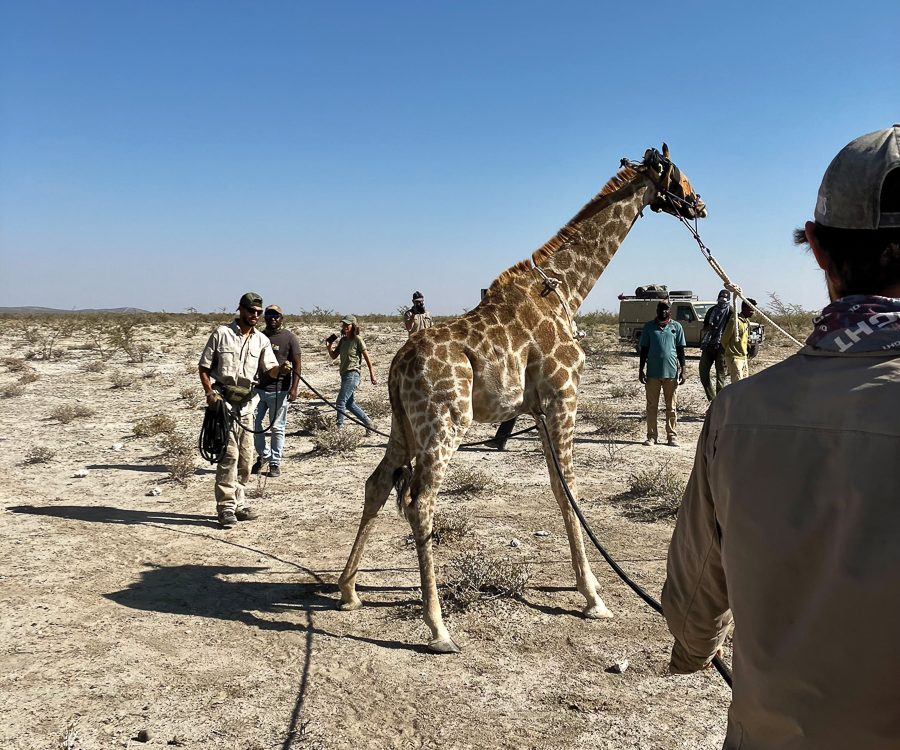Bird’s-eye view – Flamingo in Namibia
August 17, 2012It takes a village … an innovative approach to tackle rhino poaching
August 17, 2012By Ron Swilling
Long bleached grass stems push determinedly through the hard, red earth and between the scattered rocks. The soft breeze blows through stunted mopane trees and islands of spiny euphorbia reach heavenwards – desert candelabras in an arid African tapestry of red and green.
A lone cloud trails through a true-blue Namibian sky. Everything slows down and freezes as I face the Damaraland denizen, the rhino, his prehistoric form linking me momentarily to generations of his ancestors that survived the tumultuous evolutionary journey through the millennia. His ears rotate, small grey radar dishes – listening, certain that he’s heard intruders in his territory. His small, beadlike eyes scan the blurry horizon.
I inhale, keeping my mischievous breath prisoner for long seconds, like a naughty child who wants to burst out into the sunshine, while he, head up, serenely contemplates the scenario. The benevolent wind keeps the secret of my presence to herself. My heart beats too loudly.
Shhhh… I don’t move, my body rooted to the ground with a cement-like weight that feels too heavy to coax into movement, should the need arrive. All is hushed, except for the distant birds and hum of insects that are unaware of the enormity of the moment. And all is quiet, save for the long grass that dances with the memory of a good summer rainshower. The sun shines down, impervious.
The 1 100-kilogram beast lowers his head and moves on.
Life’s pause button is released and the day continues as if the frozen hiccup of time has never been. I exhale and gulp in the dry air, my throat parched. The blood flows back into my face. I have been given a reprieve to reflect on the powerful encounter and to consider why, amidst the many possible kinds of adventure, I had chosen this daunting, heart-stopping and awe-inspiring experience.
(READ ABOUT RESPONSIBLE RHINO TOURISM)
Nowadays adventure usually involves catapulting your body through the air in different ways. This more sedate rhino-tracking adventure, although just as intense an adrenalin experience, has its origins and focus in conservation, offering the rare opportunity to view the small population of black rhino that has found a home in Namibia’s Kunene Region. So, leaving the gung-ho adrenalin junkies to their escapades in Swakopmund and at Vic Falls, and the safari-seekers eager to tick off the Big Five in Namibia’s national parks, I had opted to connect to the Earth and an animal whose solid four-wheel-drive appearance belies its vulnerability.
Zero disturbance policy
Back in the vehicle, with our stomachs full and feeling revitalised, we continued scanning the dry land. In the cooler hours of the afternoon our trackers finally spotted fresh rhino tracks. They leapt excitedly out of the vehicle to investigate.
The huge tracks dwarfed their hands and gave us goggle-eyed guests a moment to comprehend the size of the animal we were soon hopefully to meet, bringing us back to the reality of the situation with a sobering start. As the trackers made off into the distance, reading the signs of the wild, oblivious to us city folk, we entertained thoughts of possible scenarios we might encounter.
We had been told that there is a zero disturbance policy regarding approaching the animals, meaning that we had to keep our distance, both for our own safety and not to stress the rhino unnecessarily. The heavy-muscled and immensely strong behemoths, if disturbed, can charge at speeds of up to 50 km/h.
The return of the trackers broke our reverie. Tired and sweaty, with fresh warm dung in hand, they explained that the rhino had moved off into rocky terrain. We continued on as the shadows lengthened, concerned that we were not going to see the elusive rhino after all.
But our tracker suddenly jumped up, pointing to the far right. “I see him, I see him,” he said, his voice ringing with anticipation and an excitement he could barely contain. We stopped to gain a better view through our binoculars, identifying the lone bull in a row of bushes, a form we wouldn’t have been able to distinguish with the naked eye.
Further on, the guide stopped the vehicle and we gingerly climbed out. The auspicious moment had arrived. Led by the intrepid trackers and guide, we followed silently in single file like a long wavering snake, obeying our guide’s hand signals and crouching down silently behind him.
And there he was, our grey giant, appearing as if from prehistory – as if he had just been conversing with the dinosaurs – and, with my vivid and overactive imagination, I understood the tragedy it would be if we, as custodians of the planet, were to bear the responsibility for his demise. But then, he lifted his head and looked cautiously in our direction… and for a few moments, time stopped.
- This article appeared in the Autumn 2012 edition of Travel News Namibia.




